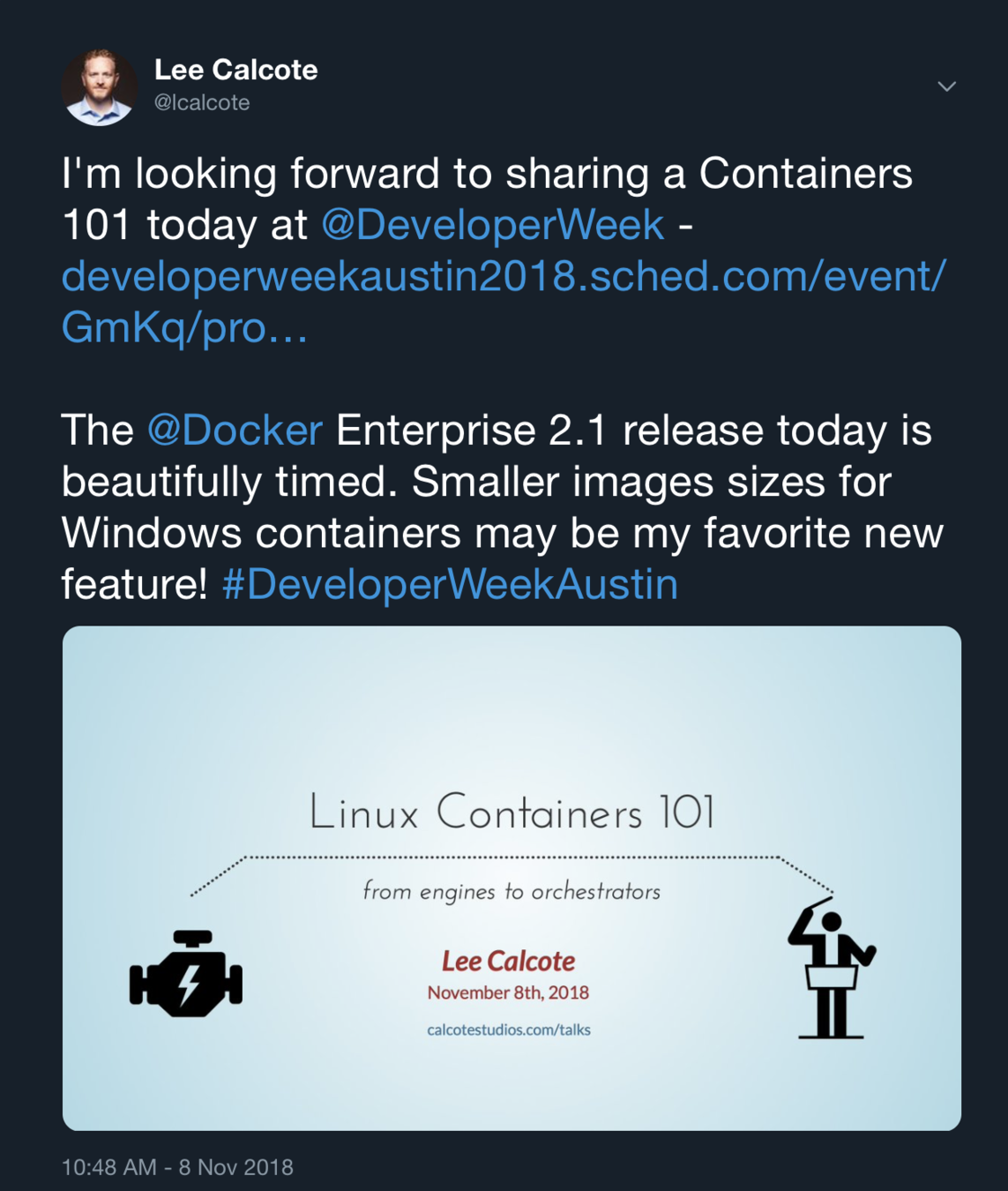Linux Containers 101

Lee Calcote
November 8th, 2018
from engines to orchestrators
clouds, containers, functions, applications, and their management










What is a Container?
What is a Container?
-
Isolated Operating System Process
-
Includes Everything The App Needs to Run
-
Shares Underlying OS Kernel
-
No translation layer
-
Inherently Portable
-
Managed by Docker Engine
Host
Operating System Definition
Application Binaries / Code
Libaries
Why use a Container?

- Efficiency
- Portability
- Security
- Choice

docker version

Dockerfile
-
Instructions on how to build a Docker image
-
Looks very similar to “native” commands
-
Important to optimize your Dockerfile
Linux container example

-
Images are pushed and pulled from registries
-
Registries can be SaaS / public or on-prem
-
Tags can be applied to images to denote versions
-
Effective Dockerfiles are extremely important

docker images

Managing Images
Stored in registries
Stateless
Immutable
Run a Container
Single task:
$ docker container run alpine hostname
Background:
$ docker container run --detach alpine top
Interactive:
$ docker container run --interactive --ttyalpine bash
Logs:
$ docker logs <container>

introductory examples

Ad-hoc exec:
$ docker exec <container> <command>
Container Network Model
Local Drivers
Docker Runtime
Bridge
Container Network Model (libnetwork)
Remote Drivers
None
Overlay
Third-party
MACvlan

Container Network Model
object model
Network Sandbox
Endpoint
Network
Container
Network Sandbox
Endpoint
Container
Network Sandbox
Endpoint
Container
Endpoint
Network
Docker Engine
Network Driver
Network Driver
IPAM Driver
Microsegmentation - traffic is not relayed

Types of Container Networking
- None
- Links and Ambassadors
- Container-mapped
- Bridge
- Overlay
- Underlay
- Host
- MACvlan
- IPvlan
- Direct Routing
- Point-to-Point
- Fan Networking
network namespace ≈ VRF
veth ≈ always come in pairs

-
A host can only expose a given port once
-
Some uses cases require the same port multiple times
-
Docker uses port mapping to achieve this

docker container run -d -p 80 nginx

Ports
docker container inspect
None
container receives a network stack, but lacks an external network interface.
it does, however, receive a loopback interface.

good ol' l0
eth0
eth1
container
network namespace
Host
l0
loopback 0
host network namespace
docker run -it --net=none alpine ifconfig docker network ls docker network inspect bridge

Bridge
- default networking for Docker
- uses a host-internal network
- leverages iptables for network address translation (NAT) and port-mapping

Ah, yes, docker0
bridge
eth0
eth1
container
container
container
Host
docker network inspect bridge

Workshop Labs
Types of Containers
the thick and thin of them
System Containers
- Like a VM
- Full OS image
- Multiple processes
Application Containers
- Single process
-
Use namespaces to deal with resource isolation for a single process.
-
Use cgroups to manage resources for a group of processes.
Similarities:
no bigotry here

- rkt
- docker
- runC
- kurma
---
- containerd
- systemd
- OpenVZ
- Solaris Zones
- BSD jails
- Linux-VServer
- AIX WPARs
- LXC
----
- LXD
- CGManager
- machinectl
----
- qemu-kvm, lkvm
System Container Engines
Application Container Engines
no bigotry here

Container Specifications


Implemented by -
- runC is the reference implementation
- runV is a hypervisor-based runtime
- cc-oci-runtime launches an Intel VT-x secured Clear Containers 2.0 hypervisor
Runtimes



Get your engines started.
and get started with your engines

Popular Engine
process models

rkt executes as CLI; no daemon
Can run Docker Images and also App Container Images (ACIs)
Security has been a focal concern
uses HTTPS to locate and download remote ACIs and their attached signatures
-
Docker Engine runs a daemon
- the defacto standard

rkt
Text

Popular Engine
process models


rkt
systemd
$ rkt run postgres
application
systemd
$ docker run postgres
application
containerd
runC

Docker Engine daemon
Definition:
[ awr -k uh -streyt -or]

[k uh n- tey-ner]
Core
Capabilities
-
Cluster Management
-
Host Discovery
-
Host Health Monitoring
-
-
Scheduling
-
Orchestrator Updates and Host Maintenance
-
Service Discovery
-
Networking and Load-Balancing
Additional
Key Capabilities
-
Application Health Monitoring
-
Application Deployments
-
Application Performance Monitoring

minimal capabilities required to qualify as a container orchestrator


One size does not fit all.
A strict apples-to-apples comparison is inappropriate and not the objective, hence characterizing and contrasting.

Kubernetes
kubectl
...and so does pronunciation.

#netiquettematters
Genesis & Purpose
-
an opinionated framework for building distributed systems
-
or as its tagline states "an open source system for automating deployment, scaling, and operations of applications."
-
-
Written in Golang, Kubernetes is lightweight, modular and extensible
-
considered a third generation container orchestrator led by Google, Red Hat and others.
-
bakes in load-balancing, scale, volumes, deployments, secret management and cross-cluster federated services among other features.
-
-
Declaratively, opinionated with many key features included

crowned the winning horse

Docker Swarm
Genesis & Purpose
-
Swarm is simple and easy to setup.
-
Swarm is responsible for the clustering and scheduling aspects of orchestration.
-
Originally an imperative system, now declarative
-
Swarm’s architecture is not complex as those of Kubernetes and Mesos
-
Written in Golang, Swarm is lightweight, modular and extensible
the easiest horse to mount

Nomad
Genesis & Purpose
- designed for both long-lived services and short-lived batch processing workloads.
- cluster manager with declarative job specifications.
- ensures constraints are satisfied and resource utilization is optimized by efficient task packing.
- supports all major operating systems and virtualized, containerized or standalone workloads.
- written in Go and under the Unix philosophy.
the nimble horse

Mesos
+
Marathon
Genesis & Purpose
-
Mesos is a distributed systems kernel
-
stitches together many different machines into a logical computer
-
-
Mesos has been around the longest (launched in 2009)
-
and is arguably the most stable, with highest (proven) scale currently
-
-
Mesos is written in C++
-
with Java, Python and C++ APIs
-
-
Marathon as a Framework
-
Marathon is one of a number of frameworks (Chronos and Aurora other examples) that may be run on top of Mesos
-
Frameworks have a scheduler and executor. Schedulers get resource offers. Executors run tasks.
-
Marathon is written in Scala
-

the Thoroughbred

Summary

A high-level perspective of the container orchestrator spectrum
minimal capabilities required to qualify as a container orchestrator

Now Available
compliments of NGINX
Lee Calcote
Thank you. Questions?
clouds, containers, functions,
applications and their management










